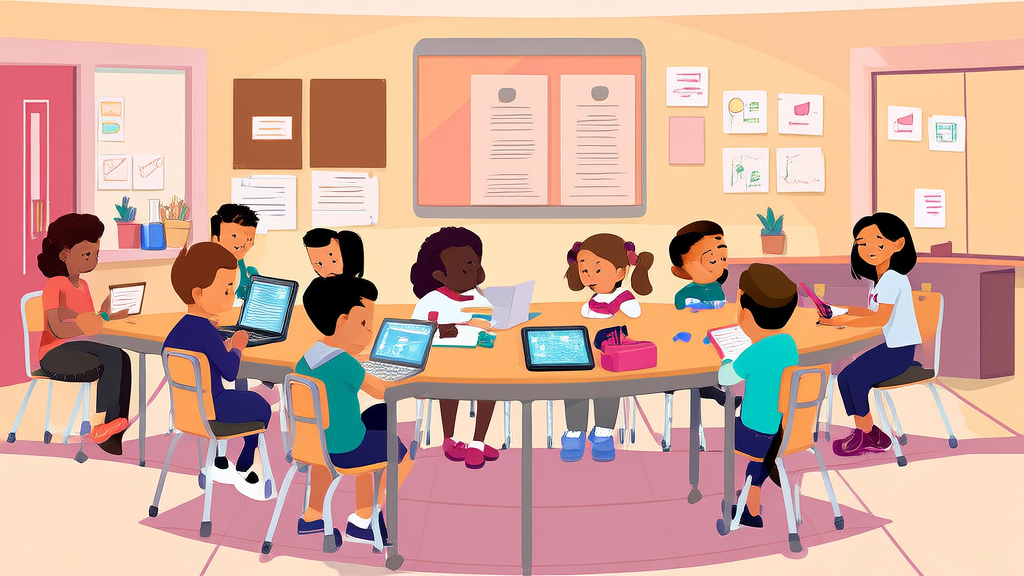5 Transformative Trends Shaping K-12 Education in 2025: PBL, SEL, and AI

Empowering the Future: Navigating K-12 Education in 2025
As we step into the heart of 2025, the landscape of K-12 education is more dynamic and innovative than ever. Parents and educators play a crucial role in shaping this environment, ensuring that students are not only prepared for the challenges of the future but are also equipped with the skills to thrive in it. This blog post explores the latest teaching methodologies, insights from child development research, trends in educational technology, and offers practical tips for both parents and teachers. Let's dive in!
Latest Teaching Methodologies and Their Effectiveness
In recent years, there has been a significant shift towards more student-centered and interactive teaching methods. Project-Based Learning (PBL) and Flipped Classrooms are two of the most prominent approaches gaining traction.
Project-Based Learning (PBL): PBL encourages students to engage in real-world projects that require critical thinking, collaboration, and problem-solving. For example, a science class might design and build a sustainable garden, integrating concepts from biology, chemistry, and environmental science. Research shows that PBL can significantly improve students' engagement and retention of knowledge.
Flipped Classrooms: In this model, traditional homework and lectures are reversed. Students watch video lectures at home and use class time for hands-on activities, discussions, and problem-solving. This approach allows for more personalized learning and immediate feedback, leading to better understanding and retention of material.
Child Development Insights and Research
Understanding child development is key to effective teaching. Recent research highlights the importance of social-emotional learning (SEL) and the impact of early childhood experiences on long-term academic success.
Social-Emotional Learning (SEL): SEL programs focus on developing self-awareness, self-management, social awareness, relationship skills, and responsible decision-making. Studies show that students who participate in SEL programs have improved academic performance, reduced behavioral issues, and better mental health. For instance, the CASEL framework provides a comprehensive guide for integrating SEL into the curriculum.
Early Childhood Experiences: Research indicates that the first few years of a child's life are critical for brain development. High-quality early education programs, such as those that provide rich language environments and opportunities for play, can have a lasting positive impact on cognitive and social development. Programs like Head Start and Early Head Start are excellent examples of initiatives that support early childhood development.
Educational Technology Trends
Technology continues to transform the way we teach and learn. Here are some of the most impactful trends in educational technology:
Artificial Intelligence (AI) in Education: AI is being used to personalize learning experiences, provide real-time feedback, and automate administrative tasks. Adaptive learning platforms, such as DreamBox and Carnegie Learning, use AI to tailor content to each student's needs, ensuring that they progress at their own pace.
Virtual and Augmented Reality (VR/AR): VR and AR technologies offer immersive learning experiences that can enhance understanding and engagement. For example, virtual field trips allow students to explore historical sites or scientific phenomena without leaving the classroom. Tools like Google Expeditions and Nearpod make these experiences accessible and engaging.
Online Learning Platforms: The rise of online learning platforms, such as Khan Academy and Coursera, has made high-quality educational resources available to a broader audience. These platforms offer a wide range of courses and materials, allowing students to learn at their own pace and according to their interests.
Practical Tips for Parents and Teachers
Here are some actionable tips for parents and teachers to support and enhance the learning experience:
- For Parents:
- Stay involved in your child's education by regularly communicating with teachers and attending school events.
- Create a supportive home learning environment with a designated study space and access to necessary resources.
- Encourage your child to pursue their interests and passions, and provide opportunities for them to explore new areas of learning.
- For Teachers:
- Integrate technology thoughtfully to enhance, not replace, traditional teaching methods.
- Focus on building strong relationships with your students to create a positive and inclusive classroom environment.
- Continuously seek professional development opportunities to stay updated on the latest teaching methodologies and educational research.
Success Stories and Case Studies
Let's look at a few success stories that highlight the effectiveness of these approaches:
Case Study 1: PBL in Action
A middle school in California implemented a PBL unit where students designed and built a community park. The project required students to apply concepts from math, science, and art. The result was a beautiful, functional park that the entire community could enjoy. Students reported feeling more engaged and motivated, and their test scores in related subjects showed significant improvement.
Case Study 2: SEL in Schools
A school district in Texas integrated a comprehensive SEL program across all grades. Over the course of three years, the district saw a 30% reduction in disciplinary incidents and a 15% increase in graduation rates. Teachers and students alike reported a more positive and supportive school climate.
Conclusion
The future of K-12 education is bright, with innovative teaching methodologies, a deeper understanding of child development, and the integration of cutting-edge technology. By staying informed and proactive, parents and educators can create an enriching and supportive learning environment that prepares students for success. Let's continue to work together to empower the next generation of leaders and thinkers.
Join the conversation! Share your thoughts, experiences, and ideas in the comments below. Together, we can make a difference in the lives of our children and the future of education.